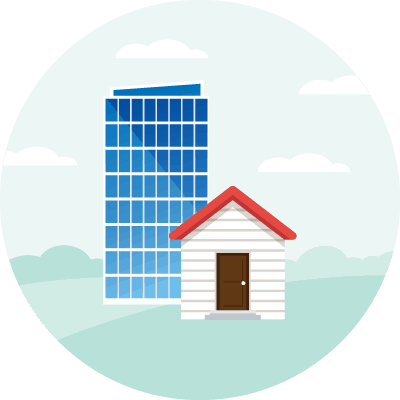What Is a Subdivision?
Why Are Subdivisions Made?
A subdivision is made to maximize income and new construction opportunities. Instead of selling or leasing a single parcel of land, the owner breaks it up into smaller pieces that can be sold or leased piecemeal, thus maximizing the income per square foot of the original parcel.
These smaller pieces of land (which are themselves called subdivisions) are legally separate from the “parent” parcel. Most subdivisions are residential, but subdivisions are made for other purposes, such as the division of an industrial lot.
An owner or buyer of the undivided land (the subdivider) can choose to subdivide their parcel. Typically, the owner hires professionals, such as surveyors and real estate agents, to learn about the relevant laws and regulations that apply to subdivisions. These professionals may also perform a cost analysis to see if the subdivision is worth the money spent to do it. This initial survey can also determine what type of subdivision is most appropriate—model homes, traditional housing, small business development, etc.
Once the subdivision proposal is approved by a planning commission, the subdivider may sell the divided lots to a developer or builder who will improve them. The subdivider may also take part in the development process.
BY THE NUMBERS: The Hawaiian Ocean View Estates (HOVE) is the largest subdivision in the United States. It has 11,500 one-acre parcels and 157 miles of driveway.
Source: Hawai’i Life
Subdivision vs. Neighborhood vs. Community
Because most subdivisions accommodate housing, the terms subdivision, neighborhood, and community approximate the same thing to many people.
However, neighborhoods typically pertain to existing communities with agreed-upon boundaries like town lines or major roadways. By contrast, subdivisions may pertain to relatively new areas developed based on a plat map[1]. Subdivisions also have different forms, from mobile home parks to exclusive, gated communities of luxury homes[2].
In addition, property construction rules that apply to subdivisions and neighborhoods depend on how those new subdivisions are zoned[3]. For example, building contractors hired for commercial projects may not be set up to handle residential ones, and vice versa[4].

Levittown, early 1950s, via Flickr user markgregory.
The typical suburban community is perhaps the most famous (or infamous, depending on one’s point of view) example of a subdivision. These consist of subdivided lots from a bigger piece of land, popularized in the economic boom of the post-war era by the real estate tycoon William Levitt[5]. As a result, many people have since thought of the term “subdivision” in a suburban context.
What Legal Description Is Used in a Subdivision?
In a residential context, subdivisions use lot and block descriptions[6].
An address starts with the lot number, followed by the number of the block on which the lot is located, then the name of the subdivision, the county, and the state.
Pros and Cons of Subdivisions
Subdivisions offer a good mix of pros and cons, which are described below.
Pros
Subdivisions (residential subdivisions, in particular) offer convenience, security, and privacy.
In communities managed by a homeowners association (HOA), residents do not have to worry about keeping streets in good repair, removing trash, and getting snow plowed, among others. The HOA collects fees from residents to operate, so every household chips in for the benefit of all.
Moreover, a brand-new subdivision will usually offer extra facilities to attract residents. There can be sports facilities, parks, a children’s playground, a gym, a community pool, bike and jogging paths, and a clubhouse, among other amenities.
Safety is also a huge benefit, especially in gated subdivisions. However, even in an open, sprawling suburban subdivision, where most neighbors know each other and often participate in regular community activities, the sense of community and looking out for one’s neighbor is an important factor. This makes living in such a neighborhood feel safer and more secure.
Finally, subdivisions are appealing to people who need more space to raise children where they have more opportunities to socialize with their peers. Those looking to find houses near good schools and safe places to play will often end up in a subdivision.
Cons
One significant disadvantage of a residential subdivision is its car-centric design. Traveling can be a pain[7] since many subdivisions do not have everything in the community (usually due to zoning regulations). As a result, families need to trek to the next city or community to reach the nearest market, medical facility, or shopping center.
A subdivision with an HOA also requires paying monthly HOA fees, which is a fund for the upkeep of the community. If a family is not using the community amenities, they are practically paying for the lifestyle of their neighbors.
Some HOAs are also restrictive. For example, residents are not free to design their houses as they see fit, which can stifle the creativity of those who wish to make some personal renovations to their houses.
This is not to say that an HOA is not open to other ideas. However, they do not approve all requests, and requests that do not conform with the rest of the subdivision are typically rejected.
BY THE NUMBERS: On average, HOA fees cost $170 a month.
Source: Bankrate
Is It Worth Buying a Home in a Residential Subdivision?
There is worth in buying a home in a residential subdivision not only because of improved quality of life but also as an investment.
A subdivision in an area projected to grow economically is likely to see properties increase in value more quickly over time. Owning a house in an upward-trending area can be an excellent way to build wealth in the form of home equity.
However, buying a residence in a subdivision can be a waste when it does not suit one’s lifestyle. Some families may prefer an urban setting, in which case a more urban neighborhood will be much more suitable. Since a residential subdivision is often developed on the outskirts of a city (or far from the city center), living in a subdivision can be dull and monotonous for someone not used to it.
Takeaways
- A subdivision is a subunit of an original, much bigger piece of land.
- It can also refer to the process of subdividing this land.
- Owners of a parcel may subdivide their property to maximize its income potential, in effect selling or leasing portions of the original property piecemeal for maximum profit.
- Subdivisions can be used for residential or commercial purposes, but they are mostly associated with residential neighborhoods, typically in a suburban setting.
Sources
- What Is A Plat Map? + What You Should Know. (2022, July 19.) Quicken Loans. Retrieved from https://www.quickenloans.com/learn/what-is-a-plat-map
- Booth, S. (2022, October 26.) What Is a Gated Community? The Pros and Cons of Buying a Home Inside. realtor.com®. Retrieved from https://www.realtor.com/advice/buy/what-is-a-gated-community/
- Teka, M. (2020, April 20.) Types of Zoning. FindLaw. Retrieved from https://www.findlaw.com/realestate/land-use-laws/types-of-zoning.html
- Yoegel, J. (2016, March 26.) What You Should Know about Subdivisions for the Real Estate License Exam. dummies. Retrieved from https://www.dummies.com/article/academics-the-arts/study-skills-test-prep/real-estate-licensure-exam/what-you-should-know-about-subdivisions-for-the-real-estate-license-exam-161242/
- What Is the Difference Between a Neighborhood and a Subdivision? (2022, May 3.) Berkshire Hathaway Home Services. Retrieved from https://bhhsselectstl.com/view-blog/what-is-the-difference-between-a-neighborhood-and-a-subdivision
- Fortenberry, J. (2022, October 3.) What is a Legal Description of Real Estate? DeedClaim. Retrieved from https://www.deedclaim.com/legal-description/
- Florida, R. (2019, October 30.) Urban and Suburban Lifestyles Are More Similar Than You’d Think. Bloomberg. Retrieved from https://www.bloomberg.com/news/articles/2019-10-30/what-time-use-data-says-about-cities-vs-suburbs








